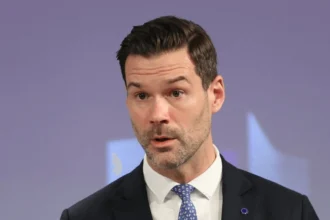Football fans should have celebrated the 2022 UEFA Champions League final between Liverpool and Real Madrid at the Stade de France in Paris. For Liverpool supporters especially, it became a disorderly and disturbing experience, nevertheless. What could have been an exciting evening of football turned into a confusing night with inadequate security and erroneous accusations directed on Liverpool supporters? Former interior minister of France, Gérald Darmanin, has apologized for the handling of the crisis following it.
Examining the main causes of the turmoil, security lapses that contributed to the crisis, and Darmanin’s apologies, this blog delves deeply into the Stade de France catastrophe. We will also consider what this incident teaches us to guarantee that the next ones are better controlled and secured.
The events at the Stade de France?
Thousands of football supporters assembled in the Saint-Denis stadium in Saint-Denis, just outside Paris, for the much-awaited UEFA Champions League final on May 28, 2022, in the Stade de France debacle. But what ought to have been a celebration of sport swiftly turned into anarchy as Liverpool supporters struggled to get into the stadium.
Many supporters were left stuck outside the stadium for hours, some of whom suffered harassment by the police, who deployed tear gas to clear the assembly. Furthermore, targeted by criminal groups were weaker supporters, who were robbed while they tried to negotiate the anarchy. Originally attributing the problem to Liverpool supporters, the French authorities claimed that false tickets led to crowding and a consequent stadium crush.
But shortly after, an independent investigation ordered by UEFA found that the real cause of the traffic gridlock was a mix of weak security measures, poor crowd control, and unanticipated increase in criminal activity. The bogus charges directed against Liverpool supporters were quite harmful, aggravating the matter even more.
Why did Gérald Darmanin apologize for the Stade de France fiasco?
Following the Stade de France disaster, Gérald Darmanin and other French officials first pointed the finger at the Liverpool supporters, which infuriated and confused others. Serving as France’s interior minister at the time, Darmanin asserted that spectators carrying fake tickets were mostly responsible for the deadly crowding at the stadium. But this justification was soon refuted.
Darmanin acknowledged in a follow-up interview that his first judgment of the matter had been erroneous “The scapegoat was easy to find, and I apologies now to Liverpool supporters,” he remarked. “They were right to be wounded. It was an error and a disappointment. Given the long-standing history of football hooliganism, Darmanin admitted that his first remarks were based on presumptions and prejudices regarding the behavior of English football fans. He also admitted he had not expected the degree of illegal behavior occurring outside the stadium.
His apologies were a significant first step toward admitting the mistakes the French government made and the shortcomings of the event’s security precautions. Darmanin’s admission of guilt also underlined the need for a more sophisticated and ready response to security at big sporting events. Read another article on Pope Francis’s Final Resting Place
What Went Wrong? The Security Failures at the Stade de France
Many security lapses led to the Stade de France fiasco. The authorities’ lack of readiness for handling the particular difficulties presented by the event was among the main problems. The French police had expected the likelihood of crowd-related incidents, including hostile conflicts between competing supporters. They were not ready for the criminal behavior that surfaced, though, as gangs targeted spectators attempting stadium.
Many of the supporters arriving at the Stade de France not only had to deal with protracted delays but also were susceptible to pickpockets and muggers, who profited from the confusion the congestion generated. Designed to confront major violence, the police force was equipped with riot gear, but this was not appropriate for handling the smaller, more nimble criminals functioning in the throng. Large boots and shields included in the riot gear made it challenging for police to take down these people, who were often fast to disappear into the throng.
Later, Darmanin said the security strategy was insufficient for the type of threat that surfaced that evening. “What you need against that kind of delinquency is officials in running shoes,” he said. This comment emphasizes the significance of customizing security policies to the particular requirements of an event and realizing that various kinds of threats call for different kinds of reactions.
How might the Stade de France Fiasco Have been avoided?
Future event management can learn a lot from the Stade de France disaster. Above all, it emphasizes the need of thorough security preparation including not just the possibility of major violence but also the probability of criminal behavior. When developing their security systems, authorities and event planners must take into account all conceivable situations—from crowd congestion to pickpocketing and violent crime.
Apart from improved preparation, the authorities should be more flexible in their reaction to unanticipated problems. For a scenario they expected, for instance, the French police had riot gear, but they were not ready for the criminal activities that developed. Crucially, security forces should be prepared and educated to manage a range of events.
Moreover, during any major event, public communication is vital. Open and honest communication can help to clear uncertainty and stop crisis-related stress. With more accurate and timely information, the Stade de France scandal would have averted needless tensions and resentment resulting from the blame assigned to Liverpool supporters.
How will the Stade de France Fiasco affect things long-term?
The Stade de France episode has had long-lasting effects on event security and French government credibility. Although Darmanin’s apology was a big start in admitting the errors made during the event, much has to be done to rebuild public confidence in the security protocols for big events.
The police and the administration of France have to act to make sure such events never recur. This covers assisting security plans, enhancing crowd control methods, and giving law enforcement personnel better instruction. Furthermore, the part criminal gangs played in the Stade de France debacle and how such crimes might be avoided at future events should be under closer inspection.
In the end: Proceeding Following the Stade de France Fiasco
Ultimately, the Stade de France tragedy reminds us very much of the need for careful preparation, clear communication, and security at major events. Although Gérald Darmanin’s public apology was a required action, it marks only the start of a far more extensive discussion on how to increase football fans’ safety and security during big events.
Although it is important to accept the errors committed during the Stade de France crisis, we also have to go forward and guarantee that next events are better prepared for a variety of possible difficulties. Using meticulous preparation, enhanced security measures, and increased communication, we can guarantee that football enthusiasts worldwide can savor the beautiful game free from the concern of injury or abuse.








